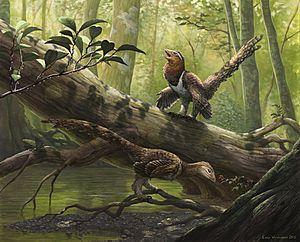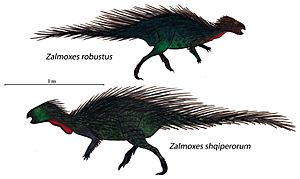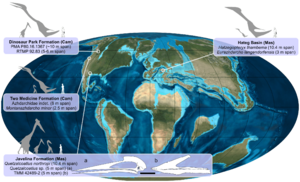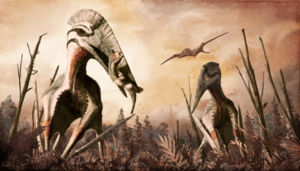Hațeg Island facts for kids
Hațeg Island was a big island that existed a very long time ago, during the Late Cretaceous period. This was the time when dinosaurs still roamed the Earth! The island was located in the Tethys Sea, which is now the area around modern-day Hațeg, Romania. Scientists have found fossils of small dinosaurs in the rocks there.
The island was formed by huge movements of the Earth's crust, called tectonic uplift. This happened when the African plate and Eurasian plate slowly crashed into each other. Today, there isn't really an island exactly like Hațeg Island. However, the island of Hainan off the coast of China might be the closest comparison in terms of climate and geology, even though its plants and animals are very different now.
The Hungarian paleontologist Franz Nopcsa had an interesting idea. He thought that when animals live on an island with limited food and space, they might become smaller over many generations. This idea is called insular dwarfism, or the island rule. Today, many scientists agree with Nopcsa's theory.
Island Geography
Scientists have estimated the size of Hațeg Island over the years. The most reliable guess is that it was about 80,000 square kilometres (31,000 sq mi) during the Late Cretaceous period. This is roughly the same size as the modern island of Hispaniola in the Caribbean Sea. The island was located near the equator, at about 27 degrees North latitude.
Hațeg Island was probably at least 200 kilometres (120 mi) away from any other large landmass. To its northwest was another island, and to the southeast was a different island. To the west was a large island that is now part of Spain and Portugal. The closest continents were parts of Europe to the west and south.
Hațeg Island was surrounded by a deep ocean basin. This was different from some other nearby islands, which were surrounded by shallow seas.
Climate and Nature
During the Late Cretaceous, Hațeg Island had a warm, subtropical climate. The average temperature was between 20–25 °C (68–77 °F). The island experienced clear rainy and dry seasons. Even with these dry seasons, the plants on the island were mostly tropical.
Scientists have studied carbon in the rocks, which suggests the island had "dry woodland" conditions. This might seem strange for tropical plants. However, tropical plants can still grow well in areas with seasonal rain, like a monsoon climate, as long as they have enough water all year round. Hațeg Island seems to have had many rivers and lakes, which would have provided plenty of water.
Early rock layers on the island show signs of volcanic activity. But in later layers, these volcanic deposits are gone. This means that volcanic eruptions likely stopped over time.
Island Animals


Scientists believe about nine different kinds of dinosaurs and several types of flying reptiles (pterosaurs) lived only on Hațeg Island. These island reptiles were different from their relatives on the mainland. This is due to something called island syndrome. It describes how animals on islands can change in size, behavior, and how their bodies work, compared to their relatives on bigger landmasses.
Many animals on Hațeg Island showed island dwarfism. This means they became much smaller than their relatives on the mainland. For example, the giant plant-eating dinosaur called Magyarosaurus dacus weighed only about 900 kilograms (2,000 lb). But its mainland relatives, like Patagotitan, could weigh as much as 69 tonnes (76 tons)!
On the other hand, some animals showed island gigantism, meaning they became much larger. Hatzegopteryx is a great example. It became one of the largest pterosaurs (flying reptiles) ever to live!
Another interesting animal was Balaur bondoc. Like some modern birds that have smaller wings and can't fly well on islands, Balaur seems to have lost its ability to fly. Scientists first thought Balaur was a type of meat-eating dinosaur called a dromaeosaurid, because of its strong legs. But now, they believe it was an early kind of flightless bird.
Most mammals found on the island were small, rodent-like creatures called multituberculates. These unique animals evolved only on Hațeg Island and developed special ways of eating insects. Scientists also found remains of one other type of mammal.
Here are some of the animals that lived on Hațeg Island:
- Allodaposuchus precedens, a type of crocodile
- Sabresuchus sympiestodon, another type of crocodile
- Barbatodon, a small mammal (multituberculate)
- Kogaionon ungureanui, another small mammal (multituberculate)
- Litovoi tholocephalos, a dome-headed small mammal (multituberculate)
- Hatzegopteryx thambema, a giant flying reptile (azhdarchid)
- Rhabdodon priscus, a plant-eating dinosaur (rhabdodontid)
- Zalmoxes robustus, another plant-eating dinosaur (rhabdodontid)
- Transylvanosaurus platycephalus, a plant-eating dinosaur (rhabdodontid)
- Telmatosaurus transylvanicus, a duck-billed dinosaur relative (hadrosauromorph)
- Struthiosaurus transylvanicus, an armored dinosaur (nodosaur)
- Magyarosaurus dacus, a giant plant-eating dinosaur (titanosaur)
- Paludititan nalatzensis, another giant plant-eating dinosaur (titanosaur)
- Elopteryx nopcsai, a small meat-eating dinosaur (troodont)
- "Megalosaurus hungaricus", a meat-eating dinosaur (theropod)
- Balaur bondoc, an early flightless bird
- Bradycneme draculae, a small meat-eating dinosaur (alvarezsaurid)
- Eurazhdarcho langendorfensis, a flying reptile (azhdarchid)
- Albadraco tharmisensis, a flying reptile (azhdarchid)
- A newly found, unnamed flying reptile (azhdarchid)
- Aprosuchus ghirai, a type of crocodile that lived later than most of its relatives
See also
 In Spanish: Isla de Hațeg para niños
In Spanish: Isla de Hațeg para niños
- Hațeg Country Dinosaurs Geopark
- Dinosaurs of Romania
- Franz Nopcsa
- Insular dwarfism



